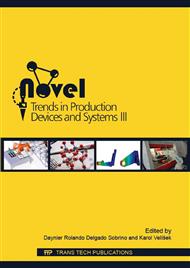[1]
P. Kaldunski P, L. Bohdal, Numerical determination of the total work value of the punch in the drawing process of automotive components, Autobusy: technika, eksploatacja, systemy transportowe. 15 (2014) 152-157 (in Polish).
Google Scholar
[2]
S.K. Panda, V.H. Baltazar Hernandez, M.L. Kuntz, Y. Zhou, Formability analysis of diode-laser-welded tailored blanks of advanced high-strength steel sheets, Metallurgical and Materials Transactions A, 40A (2009) 1955-(1967).
DOI: 10.1007/s11661-009-9875-4
Google Scholar
[3]
J. Tusek, Z. Kampus, M. Suban, Welding of tailored blanks of different materials, Journal of Materials Processing Technology, 119 (2001) 180-184.
DOI: 10.1016/s0924-0136(01)00937-2
Google Scholar
[4]
Y. Morishita, T. Kado, S. Abe, Y. Sakamoto, F. Yoshida, Role of counterpunch for square-cup drawing of tailored blank composed of thick/thin sheets, Journal of Materials Processing Technology, 212 (2012) 2102-2108.
DOI: 10.1016/j.jmatprotec.2012.05.011
Google Scholar
[5]
Z. Kampus, J. Balic, Deep drawing of tailored blanks without a blankholder, Journal of Materials Processing Technology, 133 (2003) 128-133.
DOI: 10.1016/s0924-0136(02)00215-7
Google Scholar
[6]
T. Meinders, A. van den Berg, J. Huetink, Deep drawing simulations of tailored blanks and experimental verifcation, Journal of Materials Processing Technology, 103 (2000) 65-73.
DOI: 10.1016/s0924-0136(00)00420-9
Google Scholar
[7]
K. Mori, Y. Abe, K. Osakada, S. Hiramatsu, Plate forging of tailored blanks having local thickening for deep drawing of square cups, Journal of Materials Processing Technology, 211 (2011) 1569-1574.
DOI: 10.1016/j.jmatprotec.2011.04.010
Google Scholar
[8]
L. Malag, L. Kukielka, K. Kukielka, A. Kulakowska, L. Bohdal, R. Patyk, Problems Determining of the Mechanical Properties of Metallic Materials from the Tensile Test in the Aspect of Numerical Calculations of the Technological Processes, Applied Mechanics and Materials 474 (2014).
DOI: 10.4028/www.scientific.net/amm.474.454
Google Scholar
[9]
J. Chodor, L. Kukielka, Using Nonlinear Contact Mechanics in Process of Tool Edge Movement on Deformable Body to Analysis of Cutting and Sliding Burnishing Processes, Applied Mechanics and Materials, 474 (2014) 339-344.
DOI: 10.4028/www.scientific.net/amm.474.339
Google Scholar
[10]
L. Bohdal, L. Kukielka, Application of variational and FEM methods to the modelling and numerical analysis of guillotining process for geometrical and physical nonlinearity, Mechanika 20(2) (2014) 197-204.
DOI: 10.5755/j01.mech.20.2.6941
Google Scholar


